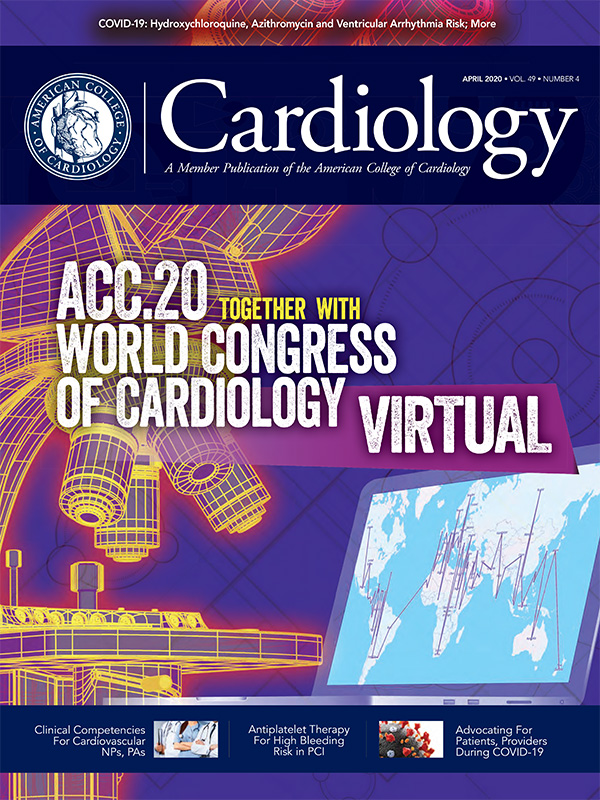For the FITs | ACC.20/WCC Top Interventional Takeaways

This year ACC.20/WCC was a virtual meeting due to the COVID-19 pandemic. The College did a phenomenal job making sure the science reached as many cardiologists as possible globally.
Beyond the trials and didactic presentations, though, I missed meeting face-to-face with colleagues and catching up with mentors from inside and outside the U.S. Networking opportunities, creating new and deepening older bonds with colleagues who share the same clinical and research interests, is a key attraction for most of us. And I share the loss with many early career cardiologists who missed their convocation ceremony and sharing it with their loved ones.
The COVID-19 pandemic is jeopardizing health care providers every day! Thank you to everyone on the front lines, across the entire care team. Be safe and be well.
Several important trials were presented during ACC.20/WCC that may change treatment and guidelines for coronary artery disease management, peripheral arterial disease (PAD), and coronary artery interventions. Let's start with the VOYAGER PAD trial that randomized patients with lower extremity PAD undergoing revascularization to rivaroxaban 2.5 mg twice daily plus aspirin vs. placebo plus aspirin.
After a follow-up of 28 months, the trial showed rivaroxaban/aspirin was associated with lower rates of cardiovascular death, acute limb ischemia, major amputation, myocardial infarction (MI), or stroke.
There was a higher rate of bleeding with rivaroxaban/aspirin, however, this was not statistically significant compared with aspirin alone. Furthermore, the benefit of rivaroxaban/aspirin was observed regardless of baseline clopidogrel use.
The findings of this trial are consistent with the COMPASS trial subgroup analysis that found the same signal with lower cardiovascular and peripheral arterial events with rivaroxaban twice daily plus aspirin.
On the same note, a substudy of the COMPASS trial presented at ACC.20/WCC had a similar finding of fewer cardiovascular events with rivaroxaban/aspirin whther or not patients had diabetes.
There was a net clinical benefit for irreversible outcomes that appeared numerically greater in patients with diabetes. I personally started to add rivaroxaban 2.5 mg twice daily since the COMPASS subgroup analysis was published, especially in patients who are considered low risk for bleeding.
Patients who have a high risk of bleeding, such as those with a recent history of stroke or previous hemorrhagic or lacunar stroke; severe heart failure; advanced kidney disease (estimated GFR <15 ml/min); the long-term use of dual antiplatelet therapy or other antithrombotic therapy were excluded from the trial and I would refrain from using this regimen in these patients.
Continuing with anticoagulation and PCI, a new analysis from the AUGUSTUS trial gave new insight into the management of triple therapy for patients with atrial fibrillation (AFib) and recent acute coronary syndrome (ACS) treated with PCI.
In this trial, apixaban plus P2Y12 inhibitor resulted in lower bleeding vs. a vitamin K antagonist with a lower rate of death or rehospitalization.
Clopidogrel was used in most cases (92.6%) vs. ticagrelor or prasugrel as the P2Y12 inhibitor. The use of aspirin in the first 30 days showed a balanced effect between severe bleeding and severe ischemic events. After 30 days, aspirin use was associated with increased bleeding without significantly reducing ischemic events.
These findings are consistent with other DOAC trials suggesting it is safe to treat AFib patients who require antiplatelet therapy with anticoagulation (warfarin studied in WOEST; rivaroxaban in PIONEER AF-PCI; dabigatran in RE-DUAL PCI; and now apixaban in AUGUSTUS) and clopidogrel monotherapy.
The current practice to treat these challenging patients is to treat with clopidogrel post PCI with a DOAC of your choice and aspirin 81 mg for 30 days only. It is recommended to refrain from high-potency P2Y12 inhibitors and warfarin in these patients due to increased bleeding risk with no significant prevention from major ischemic events.
The TICO trial evaluated ticagrelor monotherapy after three months of dual antiplatelet therapy (DAPT) vs. 12 months of DAPT after PCI for ACS. The TICO trial showed that ticagrelor monotherapy after three months of DAPT was superior at preventing net composite ischemic and bleeding events vs. DAPT.
We must keep in mind that the stent used in this trial was an ultrathin bioresorbable polymer sirolimus-eluting stent (Orsiro) that is not readily available in all labs currently. Moreover, two-thirds of patient included presented with ACS either as NSTEMI or STEMI.
These findings will give guidance for managing patients presenting with ACS who are a high bleeding risk.
Moving on, there was an interesting trial focusing on genetic testing. We always have the worry of clopidogrel not being effective in certain patients and whether genetic testing for CYP2C19 abnormality is warranted to prevent adverse cardiac events such as stent thrombosis that could be catastrophic.
Current guidelines from the ACC and American Heart Association do not recommend testing patients for the CYP2C19 genetic abnormality before prescribing clopidogrel. TAILOR-PCI trial tried to address this clinical dilemma with a prospective randomized controlled trial that was funded by the NHLBI.
Patients who underwent PCI and received at least one coronary stent were randomly assigned to conventional therapy (clopidogrel 75 mg daily) or genotype-guided therapy (ticagrelor 90 mg twice daily for carriers and clopidogrel 75 mg daily for noncarriers).
The study did not achieve a 50% risk reduction of the primary endpoint, which was the composite of cardiovascular death, MI, stroke, definite or probable stent thrombosis, and severe recurrent ischemia, with a genotype-guided strategy vs. conventional therapy.
It is frustrating. Many leaders in the field expected this trial will answer the question of genetic testing for patients receiving stents. Many think we need longer follow-up and more data, while others think this will be a moving target, especially with new iterations of stents and new antiplatelet agents.
My approach has been to use clopidogrel without genetic testing. If there is a need for high potency P2Y12 inhibitor, then prasugrel or ticagrelor will be the agent of choice. I have noticed few practices that favor prasugrel over ticagrelor after the recent ISAR-REACT 5 trial.
A highlight from the structural heart intervention arena was the POPular TAVI trial that randomized patients to anticoagulation alone or anticoagulation with clopidogrel.
POPular TAVI showed oral anticoagulation alone was associated with a reduction in all bleeding and procedural bleeding compared with oral anticoagulation plus clopidogrel with no increased major adverse ischemic events.
Finally, a few words on the ISCHEMIA trial that presented more analysis and published the others during the meeting.
My conclusion remains the same as after the initial presentation at the AHA 2019 meeting.
ISCHEMIA confirms what previous trials have shown: optimal medical therapy is safe and essential for patients with stable ischemic heart disease, with or without early intervention.
The decision for invasive therapy for stable ischemic heart disease patients should be evaluated carefully in the context of angina burden and patient's comorbidities.
Clinical Topics: Acute Coronary Syndromes, Anticoagulation Management, Arrhythmias and Clinical EP, Anticoagulation Management and ACS, Anticoagulation Management and Atrial Fibrillation, Atrial Fibrillation/Supraventricular Arrhythmias
Keywords: ACC Publications, Cardiology Magazine, Platelet Aggregation Inhibitors, Aspirin, Warfarin, Atrial Fibrillation, Fibrinolytic Agents, Acute Coronary Syndrome, Myocardial Infarction, acc20, ACC Annual Scientific Session
< Back to Listings


